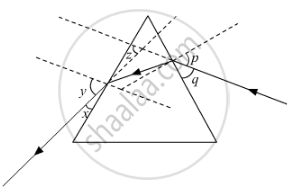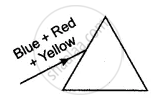Advertisements
Advertisements
प्रश्न
Study the following ray diagram:

In this diagram, the angle of incidence, the angle of emergence and the angle of deviation respectively have been represented by
(A) y, p, z
(B) x, q, z
(C) p, y, z
(D) p, z, y
उत्तर
Angle p is the angle of incidence since this angle is formed between the incident ray and the normal.
Angle y is the angle of emergence as it is formed between the emergent ray and the normal.
and angle z is the angle of deviation as it is formed between the emergent ray and the incident ray.
Hence, the correct answer is p, y, z
APPEARS IN
संबंधित प्रश्न
State the cause of dispersion of white light
What acts as tiny prisms in the formation of a rainbow?
Out of the following, the colour of light having the maximum wavelength is:
(a) violet
(b) indigo
(c) green
(d) orange
When white light passes through a prism, it ............
You are given a disc divided into seven sectors with colours violet, indigo, blue, green, yellow, orange and red in them. What would be its colour when it is rotated rapidly?
How can the presence of ultraviolet radiation be detected?
Sunlight entering through a narrow aperture falls on a prism. Draw a neat labelled ray diagram to show the formation of the spectrum on a screen. Name the colour obtained nearer the base of the prism.
In the figure, a beam of light consisting of three colours blue, red, and yellow is incident on a prism and on a rectangular glass block respectively. Complete the diagram by drawings of the refracted and emergent rays.

The splitting of white light into its component colours is called ____________.
